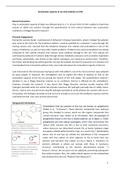Essay
IB chemistry IA on antioxidant capacity of tea with the addition of milk
- Course
- Institution
This is an IB chemistry IA on antioxidant capacity of tea with the addition of milk. The RQ is How is antioxidant capacity of black tea affected when 0, 1, 5, 10 and 15ml of milk is added to fixed total volume of 100ml tea solution, through the quantification of time interval between two consecutiv...
[Show more]



